Tracking your finances is a step most people skip when trying to make a budget or live frugally. Let me walk you through the simple process… and give you a free download to help you get started today!

If you’ve ever struggled to create a budget, or you’ve created numerous budgets but struggled to actually stick with them, it’s probably because you didn’t have an accurate picture of how much you make, save, and spend in any given month or year.
That’s where my simple Finance Tracking Workbook comes into play — think of it more as a pre-budgeting tool.
NOTE: My Finance Tracking Workbook is NOT a budget workbook.
I’m not here to help you lay out your specific budget for the year… but I will give you a tool that should eventually allow you to create a realistic budget for your current family and stage of life (if you want to create a budget)
If you don’t want to create a budget (we don’t), the Finance Tracking Workbook is still a really helpful tool that allows you to easily and instantly see exactly how much you’re spending in various categories on a monthly and yearly basis.
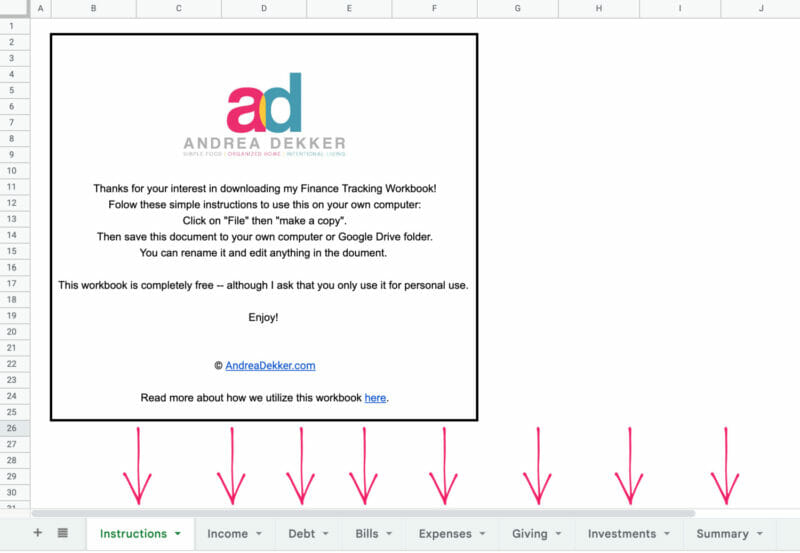
My Finance Tracking Workbook will not limit how much you can spend; it will simply tell you how much you are already spending.
My Finance Tracking Workbook will not prohibit or incentivize you to save, invest, or give… but it will tell you exactly how much you already save, invest, give, etc.
It’s nothing fancy (I’ve been using roughly the same system since I was 18 years old) but it has worked for our family for more than 2 decades and it has worked for thousands and thousands of you who have downloaded a version of this workbook since I first shared it back in 2011.
If you can commit to entering a few numbers into a Google Doc each week, you can do this!
Don’t Want to Budget? Track Your Finances Instead!
This finance tracking workbook is a great tool if you don’t want a budget.
Truthfully, we’ve never used a traditional “budget”.
Budgets have always felt too restrictive for me, as Dave and I are natural savers and don’t need to worry much about overspending.
As long as I keep tabs on how much we’re spending in certain categories, I can easily pinpoint where we could cut back if we had to, or notice less-than-ideal spending trends.
If you’re not gung-ho about budgeting, I’d still encourage you to try tracking your finances for a few months or a year. It might be eye-opening.
I know it’s been fun for us to look back over the years and see how we’ve increased spending in some categories (ahem, groceries) while cutting back in others (travel, entertainment). And also, how our income, investments, and giving have morphed over the years.
Want to Budget? Track Your Finances First!
That said, if you’d like to create a budget but just don’t know where to start or how much to realistically allocate for gas, groceries, restaurants, etc. this Finance Tracking Workbook is a great first step.
By tracking your finances for several months (better yet, do it for a whole year) you’ll quickly and easily see how much you actually spend in a variety of categories.
This will allow you to create a much more realistic budget based on your current spending (not some random percentage suggested in a book or article).
For example, if you set an arbitrary grocery budget of $500 a month… you might be frustrated, wondering why you can’t ever stick to your budget. However, if you first track your spending and realize your “normal” grocery spending is closer to $1000 a month, you can set a more realistic budget (maybe $800 a month) so you’ll have a better chance of succeeding and sticking with your budget!
Make sense?
Download my free workbook, MAKE A COPY, save it to your own Google Docs or your computer, and start tracking your savings and spending!
Let me show you around the workbook!
When you open the workbook as a Google Doc, you’ll see a page of simple instructions explaining how to save A COPY of the workbook to your own Google Drive (you will not be able to edit the original).

At the bottom of the workbook, you’ll see 7 additional tabs (or worksheets):
- Income
- Debt (reduction)
- Bills
- Expenses
- Giving
- Investments
- Summary
Once you save a copy of this workbook to your own Google Drive, you’ll have the freedom to change the names of each tab, move the tabs around, add new tabs, or even completely delete the tabs I’ve created.
In fact, you will be able to edit EVERYTHING in this workbook to make it super functional for your specific needs!
No strings attached, no fee, no email opt-in, no “red tape”.
Shocked? You’re welcome. 😊

NOTE: If you’d like more free content like this, I send a short email every Wednesday morning with tips to simplify and organize your home and life. Enter your email below and click “join now!”
Within each tab/worksheet, I’ve broken the year into 12 months (see left column on photos below), and I’ve broken each month into 4 weeks (each row = one week), which makes it easy to track how much you make, spend, give, invest, etc. on a weekly, monthly, or yearly basis.
OK, let’s dive in…
1. INCOME:
Whether you want to create a budget or not, it’s crucial to know how much income you generate on a monthly and yearly basis. Without this information, it’s almost impossible to create an accurate budget.
And even if your goal isn’t to create a budget, it’s still important to know your average monthly income.
Use the INCOME worksheet to track all your various forms of income in one place (remember, you can change the names of the headings and add more columns if necessary).
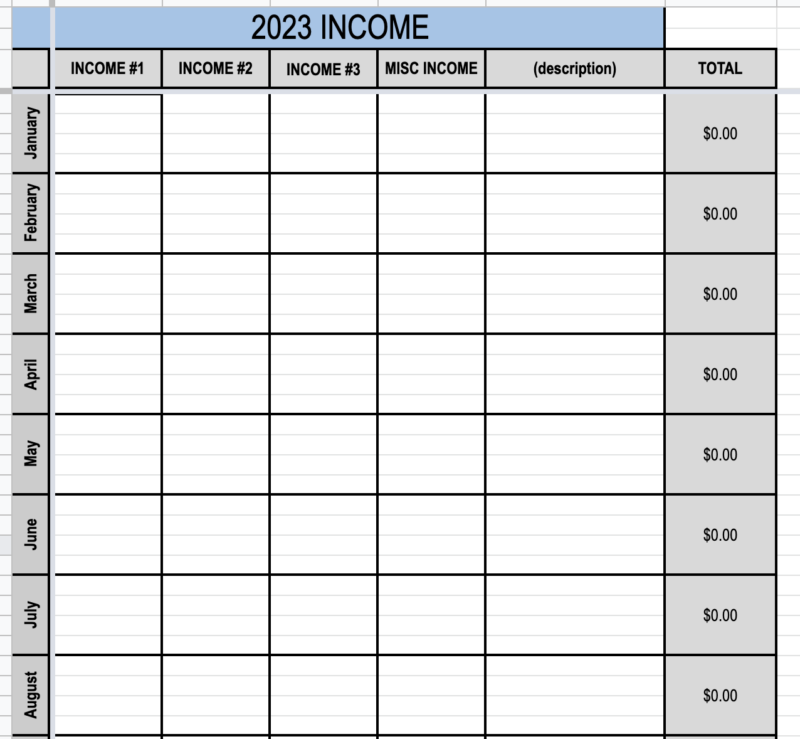
2. Debt Reduction:
If you don’t have any debt, give yourself a pat on the back and delete this worksheet!
If you do have debt, the DEBT REDUCTION worksheet is the place to record how much you’re putting toward each debt on a monthly and yearly basis.
You can also record any extra, principal-only payments you make.
Related Reading: How we paid off our mortgage in 6 years.

3. BILLS:
Use the BILLS worksheet to track recurring expenses (natural gas, electricity, trash, cell phone, Netflix, car insurance, etc. )
Feel free to adjust the column headers to whatever works for your own “bills”.
I personally put different bill amounts in different rows — this is because each row represents one week, so if a bill is due on the 3rd week of the month, I put it in the 3rd row for that month. Or if the bill is only quarterly, I post it every 3 months.
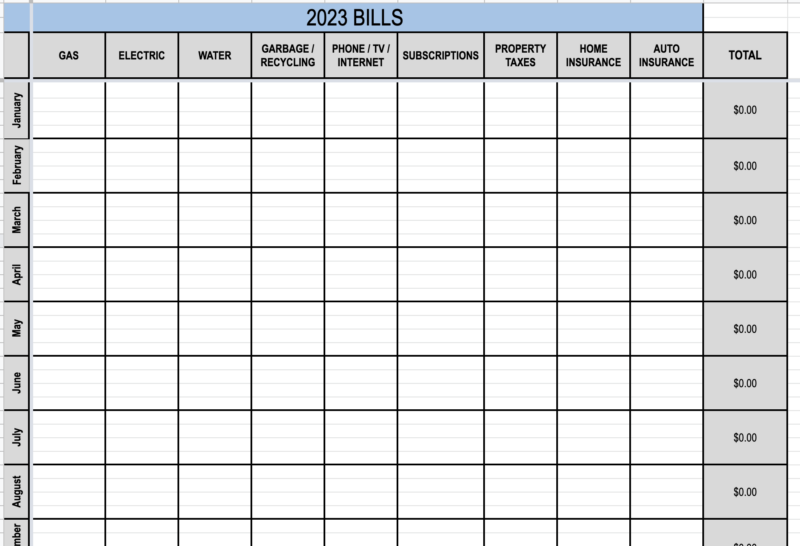
4. EXPENSES:
In my opinion, expenses are different than bills.
I use the EXPENSES worksheet to track variable expenses such as:
- groceries
- gasoline
- restaurants
- clothing
- vacations
- home renovations
- kids activity fees
Again, you can adjust the column headers to be anything you want them to be.
The EXPENSES worksheet is the one I use most often… partially because we have lots of small daily and weekly expenses to enter, but also because I like being able to quickly know how much we’ve spent in any given month or in any specific category.
It’s eye-opening to see the exact amount I’ve spent on groceries or clothing in any particular month or year. The numbers could indicate that we’re stewarding our resources well, or they could be a red flag that we need to be more intentional in certain areas.
Related Reading: Stop Money Leaks by Tracking Your Expenses

5. GIVING:
Quickly and easily track all your charitable giving and donations in the GIVING worksheet.
I have this worksheet set up to track multiple different donations (again, you can change this for your needs), and it’s always a bit of a game for me to see if we can surpass our percentage of giving each year (see “SUMMARY” page for the percentages).
This worksheet can be helpful as tax season rolls around, too (all your charitable donations listed in one place).
And it’s a great way to monitor your spending during the holidays if you keep track of your “gifts” spending.

6. INVESTMENTS:
Even if you can only invest $10 a month, you should still do it!
I’m not an investment expert, but we do pay someone to be our “investment expert” because we know how important it is to make wise choices with our money now.
I use this worksheet as a simple way to track our monthly investments.
Related Reading: How we automate our saving and investing.
Related Reading: How to start saving for retirement.
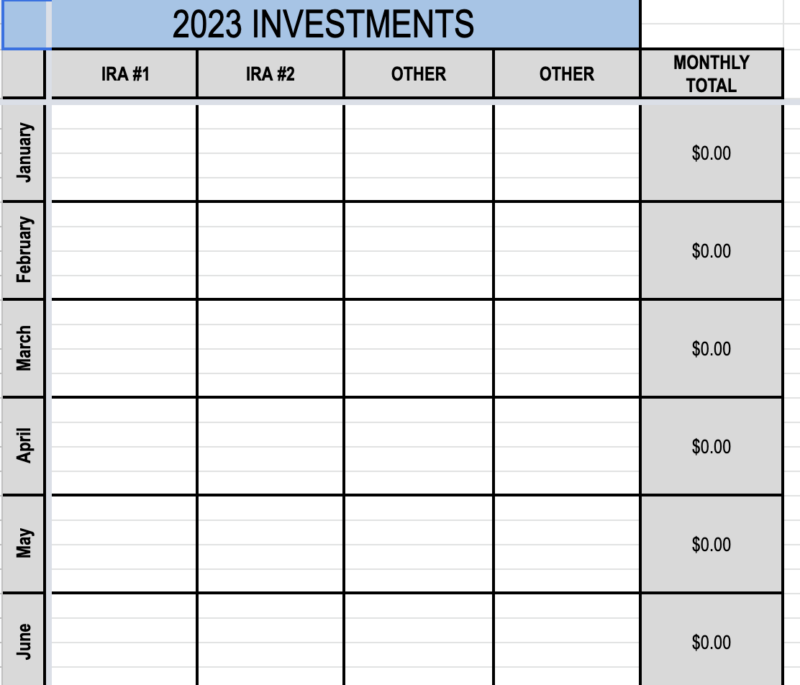
7. SUMMARY:
The SUMMARY worksheet is, well… the summary!
I have all the formulas set up, so your totals from the previous six worksheets will automatically calculate and show up on the SUMMARY worksheet.
I love this at-a-glance snapshot of our finances at any given point during the year!
I’ve also added percentages to this sheet so you can instantly see what percentage of your income is going towards giving, bills, expenses, debt, and investments. This has been a fun stat for me to track over the years.
Note: The percentage values will show an error message until you actually record an income (see image below). Also, if you get error messages on the Summary page, it might be due to any changes you made on the other worksheets.
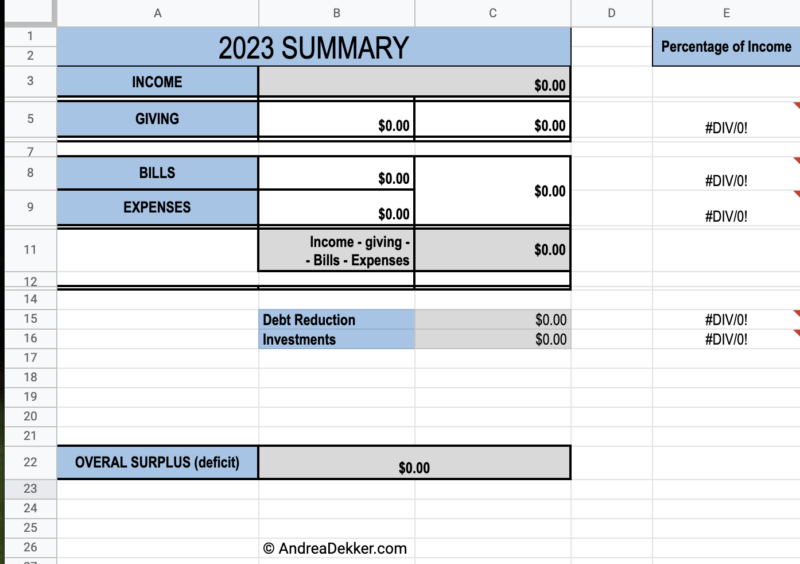
So that’s it — my simple system to track our savings and spending (say that 5 times fast.)
And it’s FREE, so you don’t have anything to lose by giving it a try!
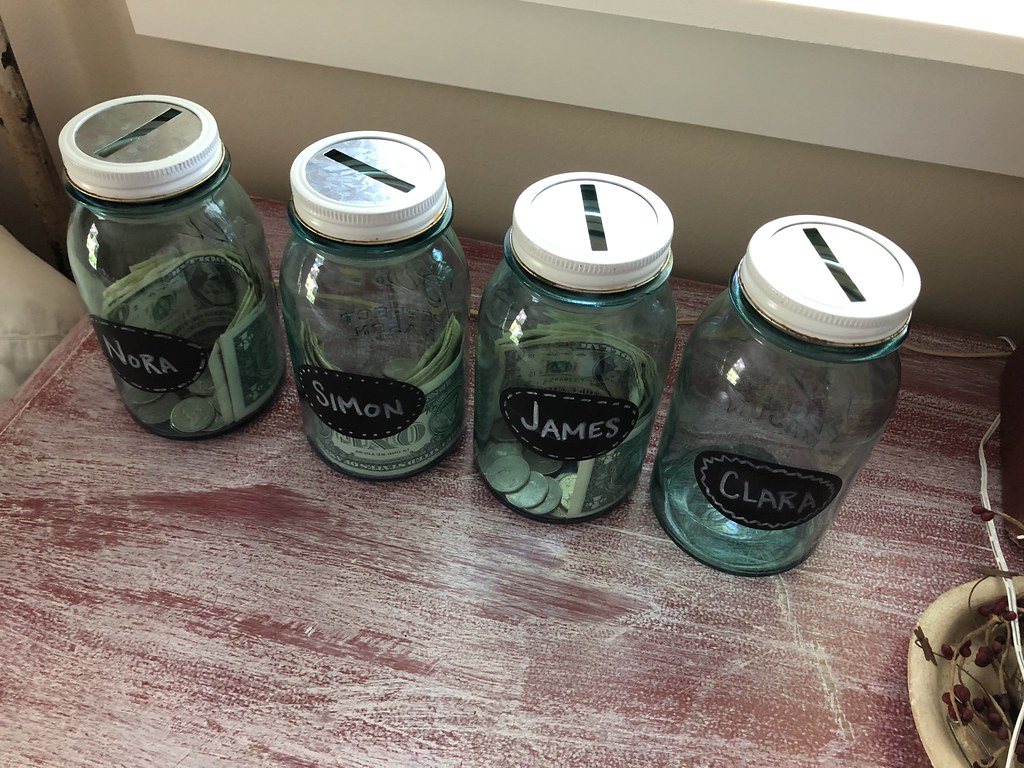
When I enter information:
One of the most frequently asked questions I get about this workbook is:
How often / when do you enter your info on the spreadsheet?
In many ways, it has become somewhat of a daily thing for me — most evenings after the kids are in bed, I’ll open up the workbook and enter anything from that day.
It takes less than a minute.
Sometimes I go a few days if there’s not much to enter.
I have a spot right next to my computer where I save any receipts that need to be entered, and I have a “To Record” folder in Gmail where I save any digital receipts, income statements, or bills until they are recorded.

Again, it’s a super simple system, but it has worked for me from my poor college days through 2 moves, 4 children, and many years of running a business from home!
If you’re looking for an easy way to get a handle on your savings and spending, I hope my Finance Tracking Workbook will work for you. Please let me know if it does 🙂
Once you start tracking your income, expenses, bills, debt, etc., you’ll have a much better handle on your overall financial situation… which means that if/when you want to create a budget, you’ll be able to use “real data” and not just throw out arbitrary numbers.
And if you don’t want to take the next step of creating a budget, you can simply enjoy looking back over the years and comparing your saving and spending (or maybe I’m the only weird one who likes to do that!)
Open my FREE workbook, make a copy, save it to your own Google Docs or your computer, and start tracking your savings and spending!
Do you currently track (or have you ever tracked) your finances?
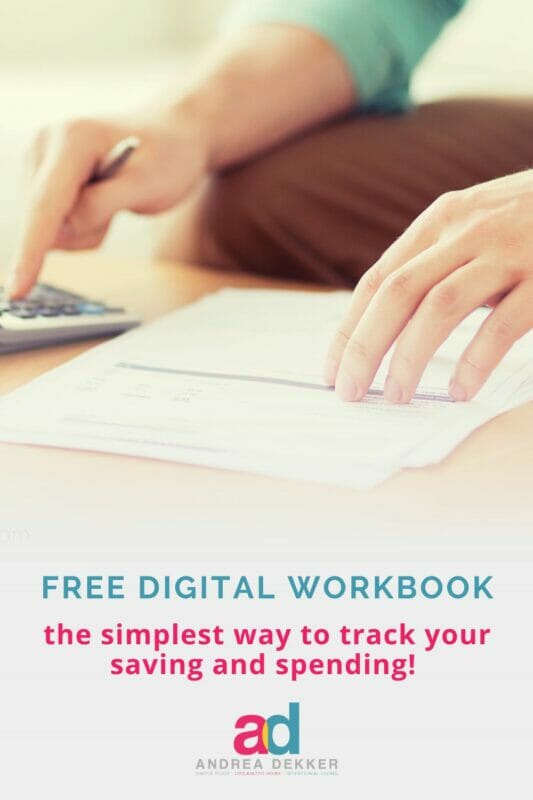

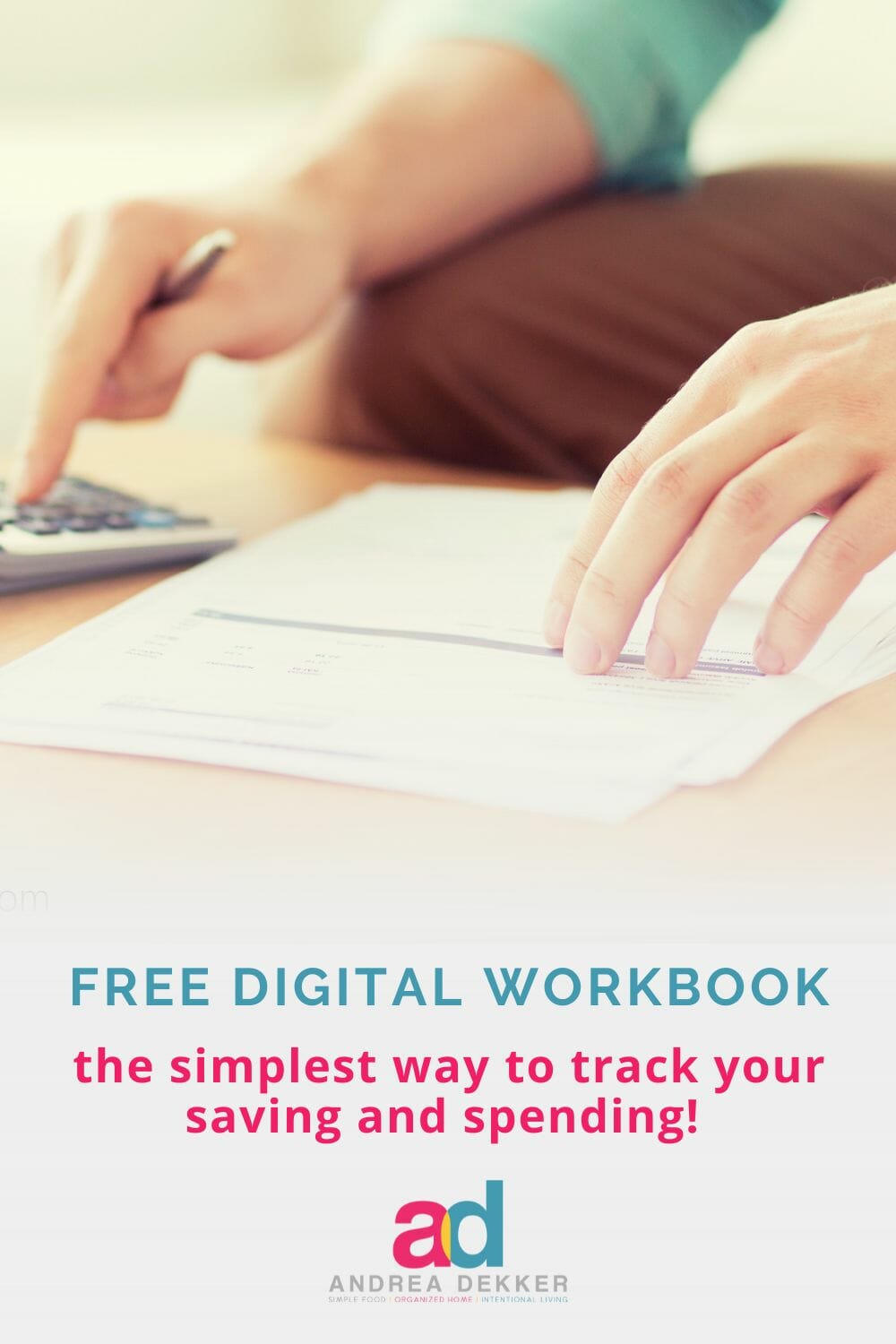
Shelley says
Hi Andrea, I will try one more time to keep track of my expenses I have to confessed that I have started couple of times and them I give up, maybe since I haven’t found and “easy” way to do it and your spreadsheet looks really friendly and easy to use.
I always have doubts on how to categorize some expenses, what will be your suggestion for:
Toll Road, Cleaners, medicines (like prescribe medication, tylenol, advil, etc), Scrapbooking supplies, School supplies (pencils, color pencil, sharpeners).
Like I said I want to keep it simple and don’t want to have soo many categories. Do you have expenses like this? where do you include them on?
Thanks,
Shelley
Shelley says
Also I put money every month to my saving account, where do you categorize the savings money?
Andrea says
I don’t — the savings is everything that’s leftover.
Keep in mind, this is NOT a budget — it’s just a record of how much money I spend on various things each month… so there’s not a category for everything since there are lots of things I don’t spend money on. You can easily add categories though (if you know how to use Excel)
Andrea says
Almost all of those expenses (besides toll roads – which I don’t have) would go under groceries for me, since I buy all of those things at the grocery store (well, I don’t buy scrapbooking supplies or school supplies at this point).
I think the thing that might be holding you up is trying to be too picky and to “exact”. I personally don’t think you need to have a million categories as that’s when it gets confusing and overwhelming. I just like to know (in general) how much I’m spending each month so I can keep track.
Shelley says
Thanks for your reply Andrea, yes I think you get to the point and I am trying to be too picky and exact. I started to work on your spreadsheet already, I only added couple of more categories, but so far I like the end up result 😉
Andrea says
yay! glad to hear you’re liking it so far 🙂
Leah says
Thank you so much for this. A big help!
Chelsea says
The only problem with this is that it is retroactive – you track what you SPENT and not what you’re GOING to spend. You don’t have control here- you just see how your money is controlling you. Glad to see more people are interested in budgeting though- there really is no excuse for not doing one, no matter your incomce. Write down income and outgo for an entire month.You won’t hit savings and giving goals if you don’t put it in the budget and then stick to the budget.
Andrea says
Hey Chelsea, That’s the whole point — to track what you already SPENT… not what you’re going to spend. The #1 problem with budgeting is that people don’t set a realistic budget because they don’t know how much money they actually spend on a daily basis.
So as I mentioned in this post — tracking your finances is the first step towards creating a realistic budget that you can actually stick to. Once you track how much money you actually spend on a daily, weekly, monthly, and/or yearly basis, than (and only then) can you really set out to create a budget that is practical for you and your life style and a budget you can actually work with without getting totally discouraged or failing after 2 months.
Jessica says
I am having so much trouble with debt reduction. I keep track of my husband’s school loans from beforehand, and also our insurance, etc. We put money towards them each month, but I don’t understand how to factor in debt reduction.
Gina says
Thank you SO much! I have really been struggling, so finding this today is a great blessing!
audra says
I’m noticing that your Income, Bills, Debt, Giving, and Investments sections only have 4 weeks – and for example, this month [Jan, 2013] 3 days of the week have 5 weeks. If you update your Excel workbook, I’d love to know about it! Thank you so much!
Teri says
Love, love, love this! Thank you!
Jeshua says
Excellent,
Thank you so much, this Spread sheet is very helpful. I’ve been researching for 20 min, it was incredibly exhausting. I will definitely use this for the whole year of 2013 if that’s possible.
!! Thank you !!
Mary says
Thank you so, so much for this! I too have been searching for something that is easy to use and this looks like it is.
My question is if you buy groceries say 3 days out of the week do you just save the totals in a book and then total them and put them in for the week?
Kaitlyn Cronin says
This is wonderful! I have a question about the debt reduction spreadsheet, however. Say you have $1000 on a credit card. In January, do you put $1000 down in the column? Then if you don’t add anything to the credit card total, but manage to pay off $200, do you put $800 in the February column? Or will the numbers then add up in the summary to appear as $1800?
Any further explanation you can give would be really helpful! My new year’s resolution (or at least one of them) is to use this spreadsheet every week!
thanks,
Kaitlyn
Andrea says
Hey Kaitlyn,
My intentions for the debt reduction worksheet was to type in how much you paid off each month. So if you have a student loan or credit card debt, simply type how much you pay each month to reduce that debt. That way, at the end of the year, you can see how much money you put towards paying off your debt.
Do that help?
Tonya says
This is great information. This year I started using an excel program, I have mine set up a little different than yours. I am also self employed and this has helped me to keep better track of my income, bills and expenses.
I too would like to know how you calculate the debt reduction.
Crystal says
Thank you SO much for this! I am not great with the computer and would have no clue how to make one of these. I am so excited to get on a budget and track our finances. I really appreciate this!
Suzanne says
My question on income is: do you list your gross or net income?
Thanks again!
melissa says
Hi! Just found your workbook through moneysavingmom. It looks fabulous! I have minimal Excel skills and have created a spreadsheet, but it’s nothing like this. My question is about the debt reduction. What exactly do I type in there and how does it factor in to the summary page? If I have a medical bill for $800 and I’m paying $50 a month on it, do I type in $800 in that worksheet or $50? Or is the $50 a bill? I’m just confused about that part. Thanks so much!
Candice says
Well, I am really excited about using your workbook and even downloaded/filled it out/ and got everything set up to work with our family’s budget. It keeps telling me it is read only and will not let me do anything now. I can’t even open it back up. Do you have any tips as to how to get around the ‘read-only’ issue I’m having. Apparently I am too much of a newb for Excel :(. Thanks for sharing the workbook!
Andrea says
Hey Candice — you actually aren’t on the right post — you should be on this post, which will allow you to download the new 2012 workbook {download it and then save it to your desktop}. I know several other people have downloaded it successfully, so if you still can’t edit it — there might be a setting on your computer that needs to be changed. Let me know if you are still having issues!
Audra says
This is a great form! I love that is keep track of one topic like expenses for a whole year on one sheet. I have been budgeting for years using an excel document that I fashioned from the Dave Ramsey style. It goes month by month. Recently, we have been having trouble with keeping track of where our money is going and then our heads are spinning at the end of the month. I think it’s because we have a 2 year old…we’ve been spinning since he was born…I think kids just add expenses that you never expect at crazy times. Anyway, do you have another form that you do for budgeting at the beginning of every month?
On another note, my neighbors went to a talk that you gave at a mom’s group…I am a teacher so I was not able to attend. They passed along your website information and I think I am addicted! I have really enjoyed reading what you have written and gathering even more ideas to stay organized. I would love to hear how the organizing continues after your little one gets here…I would have to say I was much more organized and on top of everything before I had my son! 🙂
Andrea says
Thanks Audra, glad you found my site!
Currently, that is the only budgeting form I use — so no, I don’t have anything fro the beginning of each month. I guess I’ve just been tracking our expenses for so long that I know how much I should {or should not} be spending!
Raissa says
This is absolutely perfect. I’m a poor college student and have been trying to budget for the next year so I can move into a better living situation, and this will help me keep track of what I’m spending on school, as well as what I can afford to spend on housing and whether or not I will be able to continue affording what I find.
I have been trying to create my own spreadsheet like this, but it never turns out how I want it and is not as usable as yours. This is exactly what i was searching for, and I just stumbled upon it when I least expected it.
Thank you!
Elizabeth says
I just downloaded your spreadsheet, I know I know, I’m finally getting “around to it” in October! But when I started to enter expenses, the very first one I have is for some car repairs–and I can’t find where that goes! I don’t want to put it in Misc b/c I really want to know how much our old beaters are costing us. Can I add a column and would the summary still work? Help!
Andrea says
Elizabeth, you can insert another column — but then you will have to add the formula to make it automatically add into the summary.
Oh, and it’s better to start budgeting late than never!!
Karen says
Hi Andrea! Thank you soooooooo much for this. I have tried a bunch of different ways to create a budget and track expenses, and even the Dave Ramsey software, which is awesome, doesn’t allow me to make notes or save individual months for comparison. (It has other great tools that we use, though.) Your set up is very close to what I think *I* need to be able to do this in detail, but without overcomplicating the process.
Some of your tabs have 4 weeks and some have 5, so I’m trying to add a 5th week to the ones that need it without messing up the formulas.
Do you find it necessary to compare month to month? Your summary page is for the year, so before I start reinventing the wheel by adding monthly summaries, I wanted to ask if there is something I’m just not seeing. (I need to know if we’ve gone over or are about to go over budget on a monthly basis.)
THANK YOU THANK YOU again!
Andrea says
Thanks Karen, glad my spreadsheet is working for you!
Also, I don’t specifically compare the monthly data {I’m more long-term!}, but if you look in the far right-hand column of each worksheet, you’ll see the monthly totals, so you can see how much income you make every month, how many bills and expenses you have every month, etc. Honestly, I think that should be enough to keep you on budget without creating much more work for you {over-complicating things is the #1 reason why budgets fail}
Hope this helps, let me know if you have other questions.
Megan says
Hi there! I really love this spreadsheet! Thank you for making such a great simplified tool for us to use. I always seem to make budgets too complicated and then give up on it.
Anyways, I have a question for you.. where does the information that we type into the investments sheet go when you view the summery page? Maybe that part isn’t linked to the summery page? just wondering!
Thanks again,
Megan
Andrea says
Thanks Megan,
I guess I never linked the Investments page to the Summary page because our investments aren’t very complicated…and I kind of like to keep them separate so I can see the interest grow!!
If you really want it to link together, I can probably do that and then email it to you…let me know!
Megan says
No don’t worry about it, I was just checking 🙂 Thanks a bunch!
Megan
Lacey says
This is WONDERFUL!
My husband and I got married last June and getting taxes ready for this year has been, hectic and chaotic. With this workbook, I might actually look forward to getting taxes ready.
This is so great, (and free!). Thank you!
Andrea says
Thanks Lacey! I hope my workbook helps you get a little more organized for next year!
Happy tax season!
Lynda says
Just wondering, is there a free type of excel out there? We can’t use the worksheet as we don’t have excel or the money to purchase it. I would love to use your spreadsheet – it seems to make the most sense out of the ones I have seen.
Andrea says
Lynda, the only “free” version of Excel I know of is by downloading Microsoft Open Office. I think my spreadsheet should open with this program but I’m not 100% positive — however, I suppose it’s worth a try 🙂
With Open Office, you’ll also get a free version of Word, PowerPoint, and a couple other programs so you should definitely check it out!
Hope this helps!
Lynda says
Just found a free excel type product as part as open office. Andrea I was wondering if you are able to save your spreadsheet as something other than in excel so that it can be used by other computer systems such as open office. I am not sure how to do this. Thanks.
Andrea says
Lynda, Glad you found Open Office. It’s a great tool if you’re looking for a deal!
I don’t think it’s possible to save the document as something other than Excel becuase you won’t be able to utilize the formulas I have already programed in. However, I do have one idea… I’ll email you the spreadsheet in a few minutes in a format I **think** will work. If it doesn’t, then I don’t know of any other options.
Sorry
Vicky says
Update: Google has a ‘Documents’ section in which you can create a spreadsheet. Not sure how functional it is compared to Microsoft Excel, but it’s available if you have a Google account. 🙂
Andrea says
Ok everyone, I’ve uploaded a NEW format for the free Excel Workbook…so hopefully you won’t have any more troubles opening it and/or saving it to your computer.
Simply click on any of the links in this post and it should automatically download to your computer. Then just open it up and save it where ever it’s most convenient for you.
Enjoy!!
Yvonne says
I’m having trouble downloading your spreadsheet. Any suggestions?
Andrea says
Sorry for the trouble. I just sent you an email with the spreadsheet attached. Let me know if that works better!
Yvonne says
Yes, it did. Thanks.
megan @ whatmegansmaking says
This looks like a great system! I’m married to an accountant, so he has taken charge of our finances and created some incredibly complex spreadsheet system out of them. But I like yours – it looks pretty 🙂
Laura says
This is wonderful! I have been using excel to track and manage our budget for a while, but in the back of my mind was this annoying question of wondering YTD information, summary, etc and it was on that invisible to-do list of things I’ll do at some point. Then you gave this gift right at the beginning of a new budget year! Thank you!
Someone mentioned combining toiletries and groceries and ways to track them separately and I thought I’d throw my 2 cents in. I actually keep a “budget” for separate categories in my groceries (meats, produce – includes frozen vegetables/fruits, dairy, pantry – everything else, household – cleaning products, light bulbs, etc & toiletries – shampoo, diapers, toothpaste, etc). I was getting frustrated at not being able to cut down on our groceries much and when I started tracking how much I was spending in each category, I was able to see where I could cut back and helped me plan a budget for each category so when I’m at the store and I see a great deal here or there, I know I only have so much allocated in that category and is this what I want to put money toward (or I know I have to “transfer” money from another category to fund the great sale). It does require me to sit with excel for a few minutes with whatever grocery receipts I have to enter each item individually in the proper categories, but the payoff has been HUGE! We’ve cut our grocery bill by 50% in just two months by really paying attention to what each item costs and how much each category is adding up to each week/month.
This may be terribly tedious for some people, but applying the logic of general money management/setting up a budget to our grocery budget, it really has helped me have a full grasp on where every penny of our grocery money is going (or should go) and helped me realize that that my favorite product of whatever isn’t worth the cost when it takes such a chunk of say, our dairy budget.
Anyway, thanks again for this spreadsheet – perfect timing, so simple and basic – just what I needed!
Andrea says
Thanks Laura, Glad to hear you’re another Excel user!!
I like your tip for separating your grocery budget into smaller categories to see how much you’re really saving and spending. I agree that it might be a bit tedious for some people, but it’s a great method for anyone who has a tendency to splurge, shop impulsively, or consistently go over budget!
Enjoy the new spreadsheet:)
MaryBeth @ IslandGirlBags says
Oh my…this is so what I was looking for. Thanks so much for sharing. I have a huge goal of getting us back on track and being more wise with our money.
Karen @ Abundance on a Dime says
We’ve had a monthly budget and tracked our expenses for years – however our paper system was EXTREMELY basic. We started using cash envelopes for non-fixed expenses in 2010 and really found it helpful to keep our spending in check. This year we’re giving Mint.com a try – we’re in Canada and it just recently became available for use here. The fact that all my expenses, investments, mortgage, etc can be tracked from one spot is appealing, I’m not sure if it’s going to end up being too fiddly for me though -we’ll see!!
Andrea says
Karen, it definitely sounds like you’re on the right track.
Give Mint.com a try for a year — it’s free so you don’t really have anything to use!
Good Luck 🙂
Kathy @ House of Hills says
Oh. My. Word. This might change my life. We went to envelopes on January 1 for the first time.
I am also writing down EVERY penny in a notebook because I’ve tried to use Mint and the like but it doesn’t seem real unless I’m writing it down. However, the hubby likes things on the computer. This may be our compromise.
Thank you for sharing your gifts with us all!
Kalyn says
I thought I was pretty organized with my Excel budget spreadsheet, but you got me beat! I may have to try yours now. 🙂 Love Excel!
Eos Mom says
Thank you, thank you, thank you! Tracking expenses and making a budget are a big item on my 2011 To Do List and your excel workbook *looks* like it will help a ton (of course *I* will actually have to follow through, so we’ll see how that goes). 😉 Thank you so much for this free resource!!!
Andrea says
My pleasure. Hopefully my simple worksheet will help you follow through with your goals this year!
Let me know if there is anything else I can do to help.
AnneG says
Thank you so much, Andrea! The workbook is exactly what I need to get me started; I truly appreciate it!
Andrea says
You are so very welcome!
ListfulWistful says
I’m a big fan of tracking my expenses. I only started in October, but it is already making a huge difference. I tend to be a pen & paper gal, but your spreadsheets look pretty straightforward & appealing. I might become a convert!
Quick question for you. In the image in Part 3, where you talk about expenses, you have different items on different lines in the squares. Is there any rhyme or reason to that? Like is each line a week in the month, or is it random, or what?
Thanks for sharing these!
Andrea says
Ah, yes! Each line (row) is one week! If you look over at the far left column, you’ll see each month covers 5 rows…or weeks. I know some months only have 4 weeks, but then there’s just an extra.
So, for example, when I get groceries, I put that week’s total in one square (even if I go to multiple stores). That way, I can see how much I’m spending every week, every month, AND every year for a specific category.
Does that make sense?
ListfulWistful says
Oh, good! And isn’t it good to know that your spreadsheets are user-friendly/intuitive? Nicely done!
Another question for you: Do you put shampoo, soap, etc. in grocery? Or separate them out for beauty (or is beauty strictly haircuts, etc.)? I’ve ended up lumping toiletries/groceries together to avoid having to divvy up the receipt, but then I get a little frustrated that my grocery numbers are higher when I have to replenish those things. Not a big deal in the scheme of budgeting, I suppose, but thought I’d ask since I’ve been wondering what to do with it!
Andrea says
Good question!
I actually don’t spend much money on toiletries {I get them all free after rebate} but if I do have to purchase toiletries, I put them under beauty or misc. Do whatever works best for you, but I like to know exactly how much we spend on “food” groceries, so I separate the two.
V says
I’m confused, I only see 4 rows per square!
Kari says
Ok, confession time: I’m an accountant and I don’t have a budget or track my expenses.
I jumped on board on days 1 and 2, so I might as well do this one too. It is something I have set out to do on numerous occasions, but just never stick too. Since I haven’t spent any money this year (sorry church for forgetting the checkbook on Sunday) now is as good of time to start as any. Thanks for the extra little kick in the butt. Maybe a little check-in in another month or so would be a good way to keep me accountable on my 11 in 2011.
BTW – I just found your site about a month ago and I’m loving it! As an old farmhouse dweller myself, I’m enjoying your other blog as well.
Andrea says
Do it! If you can make your bed and make freezer meals, you can certainly track your expenses in my simple Excel Workbook!
And I’m glad you’ve visited FarmhouseLove.com — I can’t wait to start updating it with all our many projects!